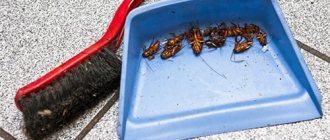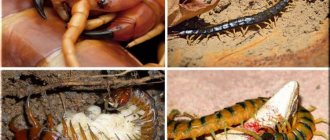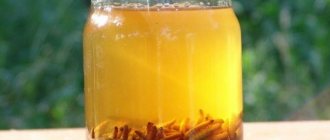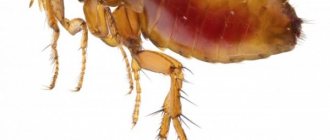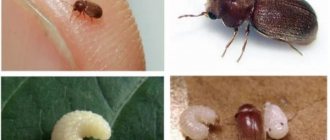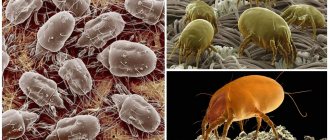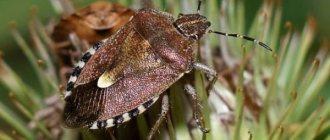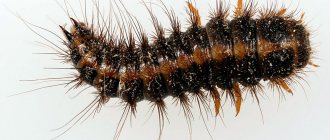- How many legs does a scolopendra have?
Whatever you say, the scolopendra is far from the most pleasant representative of the animal world, and it is also very dangerous for humans. Many species of scolopendra are poisonous and sometimes a scolopendra bite can even lead to fatal consequences; it is not for nothing that the giant scolopendra is included in the list of the most dangerous insects on the planet. Scolopendra belongs to the genus of millipedes, order Scolopendra. The name “scolopendra” is of ancient Greek origin and is translated into our language as “centipede”.
Scolopendra - description, structure, characteristics. What does scolopendra look like?
Scolopendra is very reminiscent of a long and thick worm, black or brown with splashes of green. However, the color of some centipedes may differ depending on the species. The body length of the centipede is 10-15 cm, but sometimes it can reach 35 cm.
The body of the scolopendra consists of a head and a long torso, which in turn consists of twenty (and sometimes more) segments connected to each other by flexible
membranes protected by an exoskeleton. Each segment has its own pair of legs. The first pair of legs of the scolopendra are called the mandibles; they serve the scolopendra to grab potential prey and send it directly into its mouth.
The last pair of legs of the scolopendra is also different from the rest; it is large in size and serves as a kind of anchor for the insect, at the same time helping with movement through earthly burrows.
The head of the scolopendra is like a plate with eyes, two antennae and a pair of jaws. The scolopendra's compound eyes provide it with excellent vision and good orientation in space.
Features and habitat
Scolopendra is a centipede , or to be more precise, an arthropod. They live in all climatic regions, but the giant one can only be found in the tropics; the large scolopendra especially likes to live in the Seychelles, the climate suits it best.
These creatures inhabit forests, mountain peaks, dry hot deserts, and rocky caves. As a rule, varieties inhabiting temperate zones do not reach large sizes. Their length ranges from 1 cm to 10 cm.
And scolopendras, who prefer to live in tropical resort areas, are simply gigantic, by the standards of centipedes, in size - up to 30 cm - you must admit, impressive! In this sense, the residents of our country are luckier, because, for example, the Crimean centipedes do not reach such impressive sizes.
Being predatory representatives of this species of centipede, they live alone, and they do not like living in a large and friendly family. It is rare to meet a centipede during the day, because it prefers a nocturnal lifestyle and it is after sunset that it feels like the mistress of our planet.
Pictured is the Crimean scolopendra
Millipedes don't like the heat, and they don't like rainy days either, so for their comfortable stay they choose people's houses, mostly dark, cool basements.
The structure of the scolopendra is quite interesting. The body is easily visually divided into main parts - the head and the body of the body. The body of the insect, covered with a hard shell, is divided into segments, which are usually 21-23.
It is interesting that the first segments lack legs and, in addition, the color of this part is noticeably different from all the others. On the head of a centipede, the first pair of legs also includes the functions of the jaws.
At the tips of each leg of the centipede there is a sharp thorn that is saturated with poison. In addition, poisonous mucus fills the entire internal space of the insect’s body. It is undesirable to allow the insect to come into contact with human skin. If a disturbed scolopendra crawls onto a person and runs over unprotected skin, severe irritation will occur.
We continue to study anatomy. For example, the giant scolopendra , which lives mostly in South America, with very “slender” and long legs. Their height reaches 2.5 cm or more.
The largest representatives living on the European plain are the ringed centipedes; they can often be found in the Crimea. The head of the insect, which looks more like a creepy monster from a nightmare or horror movie, is equipped with strong jaws full of poison.
Pictured is a giant scolopendra
This device is an excellent weapon and helps the centipede to hunt not only small insects, but also to attack bats, which are much larger in size than the centipede itself.
The scolopendra allows the last pair of legs to attack large prey, which it uses as a brake - a kind of anchor.
As for color, here nature did not skimp on shades and painted the centipede in a variety of bright colors. Insects come in red, copper, greenish, rich purple, cherry, yellow, turning into lemon. As well as orange and other colors. However, coloration may vary depending on the habitat and age of the insect.
How many legs does a scolopendra have?
The number of legs of a centipede directly depends on the number of segments of the body, and it is usually from 21 to 23, since each segment has its own pair of legs, then any decent centipede has 42-46 legs. It is also worth remembering that each of the scolopendra’s legs has a poisonous gland and, for example, if it comes into contact with human skin, it can cause inflammation.
Signs of a bite
The following symptoms may indicate what a scolopendra bite looks like:
- the impact of the claws of the modified legs leaves a couple of puncture wounds, around which redness and swelling occur;
- blisters, unbearable itching and pain appear at the site of damage;
- in rare cases, numbness of the inflamed area is possible.
A photo of a scolopendra bite is presented below.
A bite of an insect
The consequences of a scolopendra bite for a person can include headaches, nausea, rapid heartbeat, enlarged lymph glands, difficulty breathing and increased blood pressure. In addition to this, small puncture wounds may remain on the body, indicating the trajectory of the insect's movement.
In fairly rare cases, a complication of a bite may be accompanied by a secondary infection, necrosis, and even muscle breakdown. Some people even experienced coronary vasospasm and acute myocardial infarction.
What does scolopendra eat?
As you probably already guessed, our today's heroine, centipede, is a notorious predator of the insect world; other smaller insects act as a source of food for centipedes: earthworms, beetles,
crickets, grasshoppers, etc.
Scolopendra caught a grasshopper.
But the giant scolopendra can easily attack small ones
lizards, frogs, birds, small snakes and even bats. To catch the latter, the centipede, holding the surface with its claws, climbs to the ceiling where it sleeps, then attacks the bat with its front claws, simultaneously wrapping itself around the victim and injecting poison into it.
How to get rid of scolopendra: effective methods
There are a number of simple, affordable and effective methods for getting rid of this insect. Firstly, you need to take care of the normal microclimate in your home, making sure that there is no high humidity in the kitchen, bathroom and other rooms. The insect should not be destroyed, since there is no harm from it, but only benefit. Secondly, it is better to analyze the situation and think about what kind of insects the centipede is interested in. If she is deprived of food, she will leave the home herself. It is better to throw all your energy into fighting harmful and dangerous insects than to get rid of safe and useful creatures. Since the insect is not interested in leftover food, but feeds exclusively on insects, it is not so easy to fight it, and on the other hand, it makes no sense.
General rules
It is permissible to get rid of domestic scolopendra only using environmental methods. For example:
- Dry the rooms, getting rid of high humidity. In addition, stagnation of air masses should not be allowed, for which you need to regularly ventilate the room and monitor the operation of the ventilation system.
- Repair all taps and water supply and sewerage systems, eliminating the formation of condensation on them.
- Regularly get rid of moisture on the walls, and even more so of mold.
- Seal all cracks to prevent insects from entering.
- Use polyurethane foam to get rid of gaps between the wall, windows, doorways, etc.
- The area around the house should not have accumulations of garbage, since centipedes like to breed in such places.
- Be sure to get rid of various insects that are part of the scolopendra's diet.
Application of insecticides
There are a small number of treatments available for millipedes. Therefore, products are chosen not only to combat centipedes, but also other types of parasites
It is very important to follow all safety precautions when using insecticides. It is imperative to protect your face, hands, and other parts of the body from exposure to chemicals. Recommended use:
Recommended use:
- Medilis-Ziper is a product that needs to be diluted with water. After this, problem areas are treated with a spray bottle.
- Starex, a spray product that is good for treating cracks.
- Raid, in aerosol form, has a pleasant aroma. The product is not toxic to humans, so there is no need to leave the room.
- Henkel Combat, in special packaging, which allows it to be used for treating hard-to-reach areas. It has a strong odor.
- Globol Original, available in the form of a paste based on deltamethrin and diflubenzuron. The product is toxic, so it should be applied to the surface where children and pets cannot reach.
For those who have a negative attitude towards chemicals, a product based on natural pyrethrin is produced.
Folk remedies and recipes
It is not always possible to use chemicals. This is especially true when small children, expectant mothers, and people prone to allergies live in the house.
Boric acid
Boric acid is used to control many types of insects. It is used both as powder, which simply crumbles in problem areas, and as bait based on boric acid. Unfortunately, the centipede will not be interested in bait, but it can eat a poisoned cockroach and can also become poisoned. It is better, of course, if only cockroaches are poisoned, then the centipede will leave the house and begin to look for another place where there is something to profit from.
Use of hot pepper and diatomaceous earth powder
They are used on the same principle as boric acid powder. If a centipede runs through the powder, it will die. Death is also possible when she eats a poisoned insect.
Help from professionals
Most likely, in the fight against centipedes you will hardly have to turn to professionals for help. Most likely, such services will be required when it is not possible to get rid of cockroaches or other parasites that centipedes feed on. Special services use various methods of struggle, such as:
- Impact of temperature.
- The use of microcapsules with synthetic pyrethroids.
- Use of toxic substances.
As a rule, one treatment is enough to keep centipedes out of the house. This is, of course, good, but such a service costs a lot of money.
Types of centipedes: photos and names
There are about 600 species of these insects in nature, but we will describe the most interesting of them.
Giant scolopendra
As you probably already guessed from the name, this is the largest scolopendra, its body length reaches 35 cm. It is also the most dangerous, since its bite can be fatal to humans. The giant scolopendra lives in the tropics of South America.
Ringed scolopendra (Crimean scolopendra)
In our country it is better known as Crimean scolopendra, since its habitat is Southern Europe, including our Ukrainian Crimea. The Crimean scolopendra is not as large (and not as dangerous) as the giant one, its body length is on average 10 cm. The ringed scolopendra has a golden yellow color and is a very fast insect that eats other smaller insects.
California scolopendra
The Californian scolopendra lives in the arid regions of the Southern United States and Mexico. Its body length reaches 20 cm. It is distinguished by its bright orange color. Although its venom is not as toxic as that of the giant scolopendra, it can nevertheless easily cause inflammation of the skin in humans upon contact with the poisonous limbs of this centipede.
Scolopendra Lucas
Scolopendra Lucas also lives in Southern Europe. Its body is rusty in color and its head is heart-shaped.
House scolopendra (flycatcher)
The smallest and most harmless of centipedes, its body length is only 3 to 6 cm. Also, unlike its dangerous relatives, it has no poison and, as a result, does not pose any threat to humans. It lives in southern Europe, the Mediterranean and also in North Africa. It got its name because of its habit of settling in people’s houses, and although, as we have already noted, this scolopendra does not pose a threat, nevertheless, its presence in the house is not at all desirable. The domestic scolopendra feeds on small insects, usually flies, which is why it is even nicknamed the flycatcher.
Chinese scolopendra
This representative of the scolopendra kingdom lives in Asia, in particular China, and also in Australia. It is distinguished by its red color, which is why it is also known as the Chinese red centipede. Interesting fact: the inventive Chinese have learned to use the venom of the Chinese scolopendra for medical purposes; in the treatment of various skin diseases, it promotes the healing process in small doses.
Character and lifestyle
Scolopendra does not have a friendly character; rather, it can be classified as an evil, dangerous and incredibly nervous species of insect. Increased nervousness in centipedes is due to the fact that they are not endowed with visual acuity and color perception of pictures - the eyes of centipedes can only distinguish between bright light and complete darkness.
That is why the centipede behaves extremely cautiously and is ready to attack anyone who disturbs it. You should not tease a hungry centipede, because when it wants to eat, it is very aggressive. Running away from a centipede is not an easy task. The insect's agility and mobility are enviable.
Among other things, the centipede is constantly hungry, it chews something all the time, and all because of its digestive system, which is primitive.
Interesting fact! Researchers once observed how a Chinese red scolopendra, having dined on a bat, digested a third of the meal in less than three hours.
Most people, due to ignorance, have the false idea that scolopendra has a potent poison and is therefore dangerous to humans. But this is fundamentally wrong. Basically, the venom of these insects is no more dangerous than the venom of a bee or wasp.
Although in fairness it is worth noting that the pain syndrome from a bite of a large scolopendra is comparable in pain to 20 bee stings performed simultaneously. A scolopendra bite poses a serious danger to a person if he is prone to allergic reactions.
If a person is bitten by a scolopendra, then a tight tourniquet should be applied above the wound, and the bite site should be treated with an alkaline solution of baking soda. After providing first aid, you should go to the hospital to exclude the development of allergies.
This is interesting! People who have unbearable constant pain can be helped by a molecule extracted from the venom of centipedes. Scientists from Australia were able to find a cure for pain in the poison contained in Chinese centipedes. Now a substance is produced from the venom of predatory arthropods, which is used in a number of analgesics and antidotes.
Reproduction of scolopendra
Scolopendras become sexually mature by the second year of life. The act of copulation itself usually takes place in the silence of the night, so that no one can disturb the love idyll of a centipede couple. During sexual intercourse, the male produces a special cocoon, located in the last segment of his body; this cocoon contains seminal fluid - a spermatophore. During mating, the female draws this fluid into her genital opening, and a few months after mating she lays eggs/larvae. Moreover, up to 120 eggs are released per clutch, but not all survive. After a few more months, small ones emerge from the scolopendra larvae.
Who are centipedes
The centipede or flycatcher belongs to the order of centipedes, which has more than 12 thousand species of individuals. The insect has a flat body divided into 15 segments. Each segment has a separate pair of legs attached. The smallest pair of legs is located almost at the very head - these are peculiar jaws that serve as a tool for the insect to hold caught prey. The number of legs of a flycatcher depends on its age, the maximum number of legs is 354. In most cases, centipedes live up to 7 years.
The last pair of legs is much longer than the other legs, and from a distance they resemble front antennae. At first glance, when meeting an insect, it is not immediately possible to determine where its head is. The size of the insect varies from 4 to 6 cm in length, the running speed is up to 40 cm per second. On the sides of the head, the centipede has faceted organs of vision that perfectly distinguish objects even in complete darkness. The arthropod also has an exoskeleton consisting of substances such as sclerotin and chitin. The color of centipedes is mainly gray-yellow; there are 3 longitudinal stripes along the body.
Is scolopendra dangerous for humans?
Regarding the danger of scolopendra to humans, the giant scolopendra that lives in the jungles of South America is especially dangerous; its bite can actually cause severe poisoning, even death. As for the Crimean scolopendra living in our country, although it is not fatal, nevertheless, you should stay away from it.
Symptoms of a scolopendra bite (in particular our Crimean one):
hornet,
This discomfort lasts about two days.
Interesting fact: female scolopendras are more poisonous and dangerous than males.
Description
Scolopendra is a centipede that belongs to the class of arthropods. In most cases, these predators (since they feed on other insects) are poisonous and pose a danger to people. Meeting a centipede in the house is not the most pleasant event, and you should get rid of it as soon as possible.
Where do scolopendras come from in the house? Millipedes love moisture and are therefore often found in basements, bathrooms and kitchens. They come to the apartment not only for comfortable living conditions, but also in search of food.
What to do if a centipede is spotted in the house? What to do if she bites? What measures should be taken, and what means of combating scolopendra are more effective: folk or professional? The answers to all these questions can be found in the article.
What to do if you are bitten by a scolopendra
First of all, of course, it is best to simply prevent the scolopendra from biting you. She herself is unlikely to specifically attack a person, but she can bite in a state of fright and self-defense. Very often, scolopendras have a bad habit of crawling into tourists’ tents, so to avoid unwanted guests:
- use a closed tent with a zipper, and even such a tent should not be left open unattended.
- Inspect your tent thoroughly before going to bed.
- In the morning, check your clothes and things for the presence of scolopendras, they like to arrange a shelter for themselves in these items.
- Also remain vigilant when turning over stones or collecting dry branches, as centipedes may be hiding there.
If it does happen that scolopendra runs across a person’s skin, leaving a mark in the form of an inflamed stripe, measures should be taken immediately:
- wash the affected area with soap and water or disinfect with alcohol.
- then apply a sterile bandage.
- to drink a lot of water.
- provide peace to the victim.
- Do not drink alcohol under any circumstances (it speeds up the body’s metabolism, and with it the effect of scolopendra poison).
- It is highly advisable to consult a doctor for professional medical help.
If a scolopendra has bitten a pregnant woman, a child, an elderly person, a person suffering from cardiovascular diseases or prone to allergic reactions, then immediately going to the hospital for professional medical help is mandatory!
How to protect yourself?
It should be remembered that the giant scolopendra is not an insect, and therefore fumigators and various aerosols do not affect it. You can kill it mechanically, but it’s difficult to do. This centipede is very nimble.
It is best to follow basic safety precautions. In areas where giant scolopendras live, wear thick clothing that covers most of your body. Don't sleep outside your tent. Carefully turn over old logs and stones - centipedes often choose these places for shelter.
When meeting her, try to simply avoid direct contact, bite, or touching your skin with the legs of the centipede. If you are unable to protect yourself, do the following:
- Wash the bite or contact area with cool water and soap.
- Disinfect the skin with alcohol or any other antiseptic.
- Apply a sterile dressing. Change it after 12 hours.
- Take an antihistamine.
- Drink more fluids, but avoid alcohol (it speeds up metabolism and thereby enhances the effect of the poison).
- Stay calm and monitor your condition.
- Contact your doctor if you feel unwell.
Prevention
The best method for preventing scolopendra bites is to minimize contact with it. Therefore, when hiking, it is better to wear closed clothes and not try to touch unfamiliar animals with your hands, and when traveling to exotic countries, follow the instructions of the guides. If, however, the scolopendra runs over your body, ending up on your arm or leg, then you should try not to scream or try to kill it right there, but simply carefully throw it to the ground.
In the south of Russia, the ringed scolopendra can crawl into the house. This is prevented by measures to create uncomfortable conditions in the living room for its penetration:
- seal all the cracks in the house;
- eliminate dampness and dry rooms;
- install ventilation grilles;
- get rid of the insects that the centipede feeds on - flies, ants, moths.
How else can you get rid of centipedes in the house? - use chemicals. Conventional insecticides, such as Dichlorvos NEO, Raid, and Clean House, have proven themselves to be reliable means. Premises must be processed using personal protective equipment.
There are wildlife lovers who keep centipedes at home in special terrariums. They need to remember that the domestic scolopendra does not lose its natural essence and remains dangerous to humans.
Let's summarize. Scolopendra is a predatory invertebrate animal that lives in tropical and subtropical zones. It is armed with a stinging apparatus and zootoxin, and is therefore dangerous to humans. The ringed scolopendra, which lives in southern Russia, is moderately poisonous. Children, pregnant women and the elderly are most susceptible to its bite. The main emergency measures include copious washing of the wound, treating it with an alcohol solution and applying a sterile bandage. Inpatient treatment is most often not required. The consequences of intoxication with zootoxin are asthenia of the body and decreased immunity. To prevent a scolopendra bite, you must follow safety measures when hiking and traveling in southern latitudes. Residents of the subtropics need to eliminate dampness in their homes to avoid millipedes from entering them.
